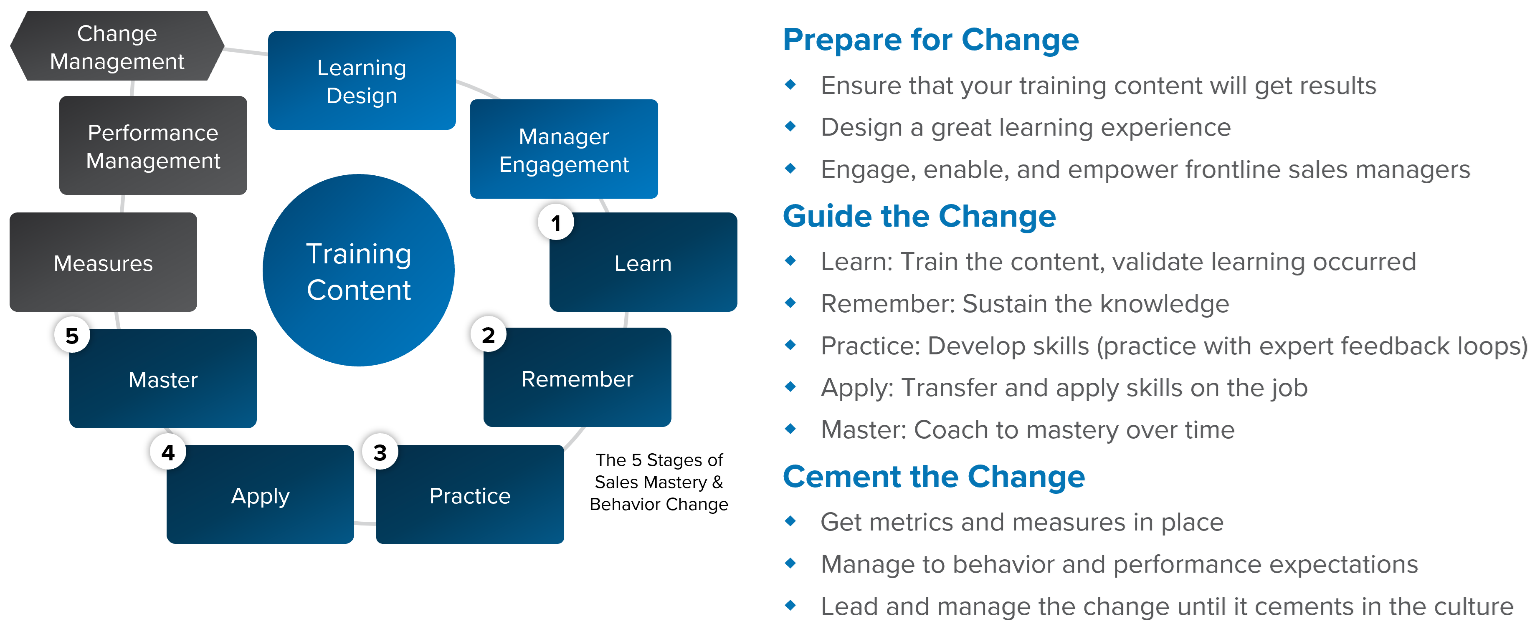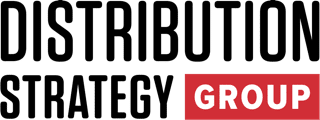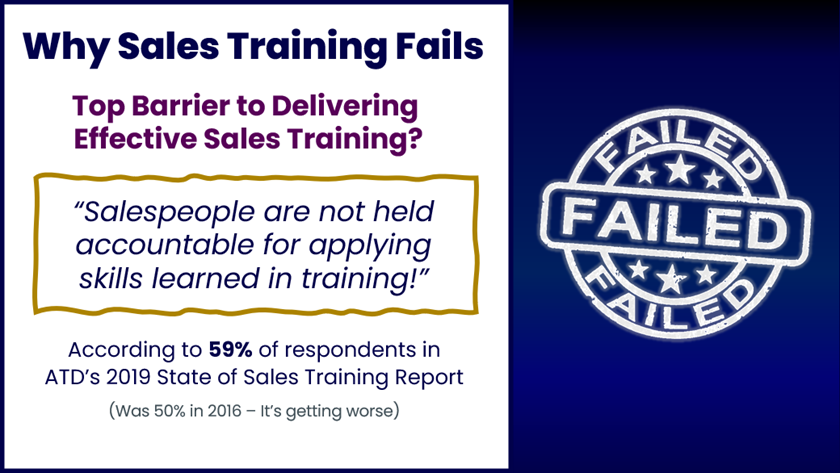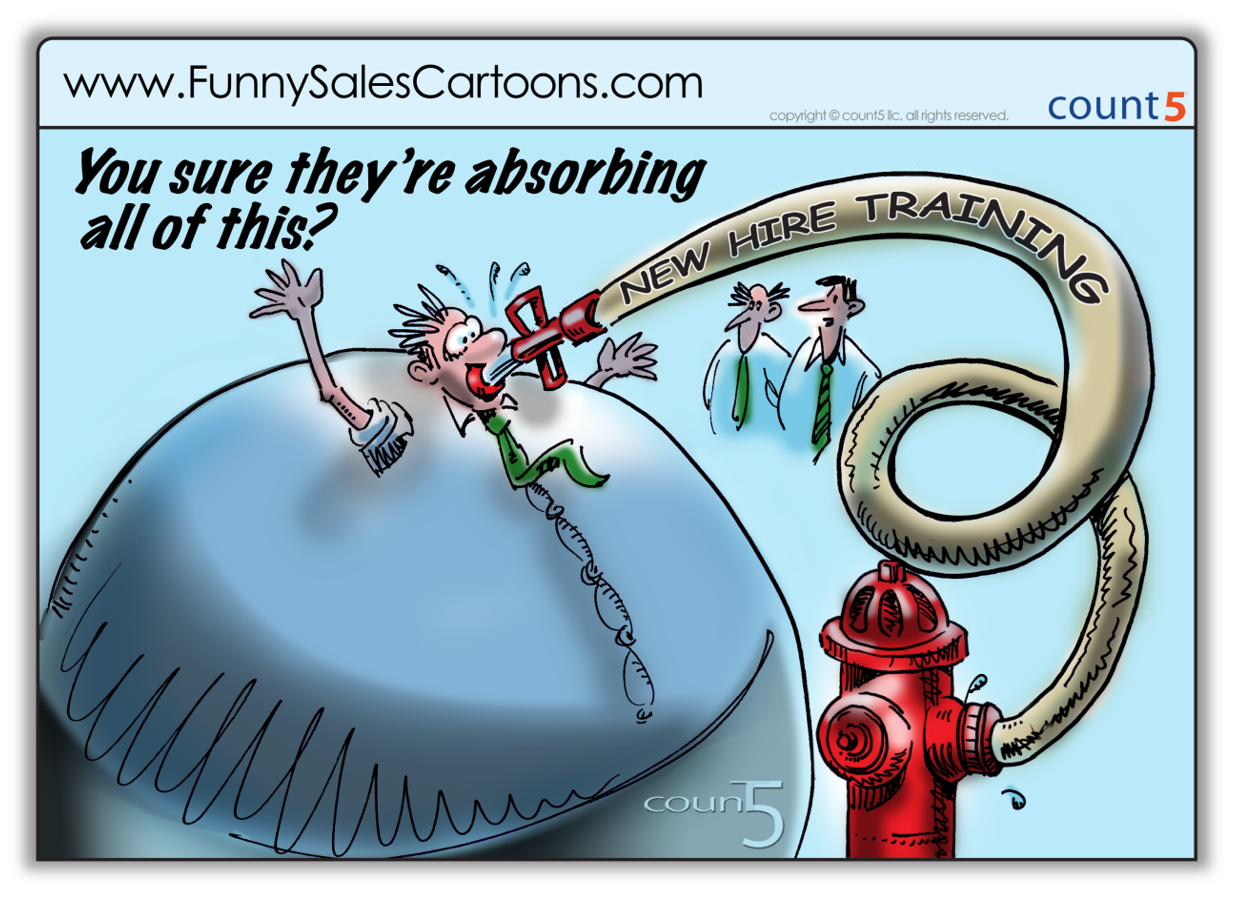If you’re a CEO or head of sales at a B2B industrial or electrical distributor, you’ve likely invested in sales training—maybe more than once. And if you’re like most distribution leaders, you’ve also been disappointed by the results.
It’s not that your reps didn’t learn anything. It’s that they didn’t change. They may have forgotten what they learned (the forgetting curve) or didn’t apply it. Or if they did apply it, it didn’t feel comfortable, and they didn’t stick with it. And worse, because they didn’t stick with it and eventually reach mastery, there were no discernable results or ROI.
Basically, the training didn’t stick.
And that’s not just frustrating, it’s expensive. Worse, it’s a missed opportunity to improve sales effectiveness, drive revenue, and build a competitive advantage.
This isn’t a salesperson problem. It’s a system problem. And it’s time we talked about why sales training fails so often, and what to do differently.
Why Sales Training Fails
Let’s start with the uncomfortable truth: most sales training programs are doomed from the start. Not because the content is bad (although sometimes it is), but because the conditions for success don’t exist.
Here’s what typically goes wrong.
- Training isn’t the right solution for the problem
Leaders who are inexperienced in performance consulting (aka human performance improvement) or training needs analysis often misdiagnose sales performance issues. If the root cause is a hiring mistake, a broken process, unnecessary bureaucracy, or poor sales management, training your salespeople won’t fix it. See the above links if you’d like to learn more, and click this link to view two root-cause diagnostic tools. - The training content won’t produce results in the real-world
Even when training is the right solution, the content can miss the mark. If it’s outdated (not designed to work with modern buyers), disconnected from the realities of distributor sales (all new business development without account management), or not based on what top performers do differently, the results will be poor. According to Korn Ferry, only 17% of companies report having an effective training program. Having worked in the sales performance improvement field for over 30+ years, I find this mind-boggling, but it is a sad reality. - Poor learning design
Many programs aren’t designed for how adults learn. This is especially true for internally designed programs that weren’t developed by an expert instructional designer. They rely on lectures, cram content, and fail to engage learners or provide practice. Adult learning theory emphasizes self-directed, problem-centered learning with immediate relevance. - No reinforcement or sustainment plan
Training is often treated as an event, not a process. Reps attend a workshop or watch a video, then go back to work with no follow-up. Research shows that learners forget 90% of training content within one week unless it’s reinforced. (Source: Brain Science: The Forgetting Curve–the Dirty Secret of Corporate Training – Learning Guild) - Lack of practice and feedback
This is part of reinforcement and sustainment but is a very specific and effective type–deliberate practice with feedback loops. Reps don’t get enough opportunities to apply what they’ve learned, receive expert feedback, and refine their skills. Rote repetition alone does not improve performance. Deliberate practice, especially when paired with feedback, is essential for acquiring expertise. (Source: Practice for knowledge acquisition) - No transfer plan
Transfer is a learning term for getting students to apply what they learned or “transfer” their learning from the training to the workplace. When there’s no structured approach to help reps apply new skills in their day-to-day work, the learning stays in the training program. - No coaching to mastery
Far too often, managers aren’t equipped or expected to coach reps through the learning curve to achieve sales mastery. Yet companies with effective coaching see an average revenue increase of 8.4% year-over-year (meaning continuous improvement—often the initial performance lift is much higher if the content is right). - No measurement or analysis
There’s no plan to track transfer, adoption, behavior change, or business impact. So, leaders can’t tell what’s working or what needs adjustment. - No performance management
As the image above reports, in many companies, reps aren’t held accountable for using what they learned. Training transfer and adoption become optional, and behaviors don’t change at all or soon revert to the old way of doing things. - No change management
To make an impact, training requires behavior change, which means managing resistance, aligning stakeholders, and supporting the transition. These things rarely happen organically, without a purposeful and well-constructed change management plan. - No executive support
Without visible, top-down commitment, training and the related behavior change we’re discussing feels optional. Reps and managers don’t take it seriously. We know that what gets measured gets done, but we sometimes forget that what gets asked about gets attention and focus. Especially when leaders are asking. - Too much content is delivered all at once
Overloading reps with information in a short time frame strains what researchers call working memory, which leads to cognitive fatigue and poor retention. In simpler terms, the “firehose” approach doesn’t work.
- No integration into workflow and systems
Training lives in a vacuum. It’s not embedded into CRM, sales process, or daily routines—so it’s forgotten.
The Solution: A System That Makes Training Stick

Use bite-sized learning
Break content into digestible chunks that reps can absorb and apply. Think short videos, summaries, and worksheets—not marathon classroom training. This aligns with adult learning principles and improves retention.
Apply spaced repetition
Revisit key concepts over time to reinforce learning. This fights the forgetting curve and supports long-term retention. Research shows spaced repetition can improve recall by up to 200%. (Supported by multiple studies, including one by Karpicke & Bauernschmidt in 2011 at Purdue University.)
Use retrieval learning
Ask reps to recall and apply what they’ve learned, rather than just re-reading or re-watching. This strengthens memory and understanding.
Engage managers in reinforcement
Train managers first and then have them lead weekly reinforcement sessions. This builds accountability and creates a coaching culture. IBM’s coaching-centric approach led to measurable improvements in win rates.
Teach reps to think, not just recite
Move beyond scripts and playbooks. Help reps understand buyer needs, think critically, and tailor their approach. As I’ve written before, “rote messaging doesn’t win deals—thinking does.” Read more here: Beyond the Playbook: Why Teaching Salespeople to Think Is Your Best Competitive Advantage
Spread training over time
Deliver training weekly, not in a single event. Use a mix of formats: video, content summaries, worksheets to prepare to apply what was learned, and manager-led reinforcement sessions with practice and coaching. This keeps it engaging and actionable.
Focus on buyer-centric consultative selling
Teach reps to create, communicate, and confirm value effectively. Help them become trusted advisors and problem-solvers, not just order-takers.
Ditch outdated sales techniques!
Forget “overcoming objections,” “closing,” and especially stereotypical, old-school manipulative selling. You might think these things are in the past, but I’m surprised how often I still see them in action and recommended by “selling gurus.” These combative, manipulative tactics don’t work in today’s buyer-driven market, especially with the younger generations who are moving into higher-level positions in customer organizations. Instead, teach reps to understand needs, raise, and solve problems, resolve concerns, gain agreement on logical next steps, influence ethically, and communicate far more intentionally and effectively. They need high degrees of business acumen, critical thinking, problem-solving ability, and exceptional communication skills.
Measure what matters
Track behavior change, adoption, and business impact. Use performance dashboards, conversation intelligence analysis, and feedback loops to monitor progress and adjust as needed.
The Proof: What Happens When You Get It Right
When distributors implement a system like this, the results speak for themselves.
· 19.1% more sales per order
· 12.1% overall sales growth
· 14.5% higher gross margins
· 2.5x more new accounts opened
· 25% growth in total sales
· 9.8% higher median gross margin
· 7.4% better top-line sales growth
These results come from multiple studies across industrial and electrical distributors, comparing trained sellers to their untrained peers. The data are clear: when we do the training right—and reinforce it through coaching and systems—it drives real performance improvement.
And when you layer in negotiation training, the impact grows:
· 16.8% reduction in discounts/overrides
· 3.9% additional lift in sales results
· 2.3% increase in strategic sales mix
· 45.6% overall increase in sales
These aren’t theoretical improvements. They’re real-world outcomes from distributors who invested in training that sticks and implemented as discussed in this article. It’s entirely possible to achieve these results.
Closing Thoughts
Sales training doesn’t fail because reps are lazy or incapable. It fails because the systems around the training are broken. This is a leadership, cultural, and organizational issue.
If you want real behavior change and the very real business results that come with it, you need a system that supports learning, practice, application, coaching, and accountability. And one that incorporates change management with a “stick-to-it-iveness” rivaling a Dachshund with a bone. (Fellow Doxie owners will know what I mean.)
If you want your managers to lead that change, you also need to train them first and to have strong sales management foundations with a sales management operating system, and a formal sales coaching methodology.
Easy? Maybe not, but it’s what gets results. Worth it? You tell me… would a 25-35% improvement in revenue be good for your company? Yeah, I thought so.
Mike Kunkle is an internationally recognized expert on sales enablement, sales effectiveness, sales training, sales coaching, sales management, and sales transformations.
He’s spent over 30 years helping companies drive dramatic revenue growth through best-in-class enablement strategies and proven effective sales systems.
Mike is the founder of Transforming Sales Results, LLC where he designs sales training, delivers workshops, and helps clients improve sales results through a variety of sales effectiveness practices and advisory services.
He collaborated to develop SPARXiQ’s Modern Sales Foundations™ curriculum and authored their Sales Coaching Excellence™ and Sales Management Foundations™ courses.
Mike's book, The Building Blocks of Sales Enablement, is available on Amazon, with others coming soon in 2026, starting with The CoNavigator Method for B2B Selling.





